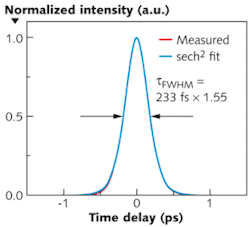DIODE-PUMPED SOLID-STATE LASERS: Yb:YAG ceramic laser produces modelocked pulses

Doped ceramic is the gain material of the future for many forms of diode-pumped solid-state lasers: if fabricated correctly, a ceramic gain material can have the transparency and the performance of a crystalline gain material, while being much easier and quicker to manufacture. In addition, ceramics can be harder, tougher, and more resistant to thermal shock than single crystals.
Research into ceramic laser materials has been growing, especially in Japan. Now, researchers at Ibaraki University (Ibaraki, Japan) and RIKEN (Saitama, Japan) have demonstrated the first modelocked ytterbium-doped yttrium aluminum garnet (Yb:YAG) ceramic laser, a device that has demonstrated the shortest pulses for diode-pumped ceramic lasers without Kerr lens modelocking: 286 fs pulses at a 25 mW average power and 417 fs pulses at a 250 mW average power, both in the 1030 nm wavelength region; and 233 fs pulses at a 20 mW average power for a 1048.3 nm wavelength.1
In the experiment, a fiber-coupled 940 nm laser diode, the fiber output of which was imaged by relay lens, pumped the ceramic at a maximum power of 26.6 W. The Yb:YAG was mounted to a water-cooled copper block and placed between two curved cavity mirrors. A semiconductor saturable-absorber mirror with 2% saturable absorption at 1030 nm, 70 µJ/cm2 saturation fluence, and a 500 fs relaxation time constant was part of the mode-locking arrangement.
Using a 1% output coupler, the laser produced 417 fs pulses at 1033.3 nm, a repetition rate of 91 MHz, and a spectral width of 3.02 nm. With a 0.1% output coupler, the pulse width was 286 fs, the spectral width was 4.51 nm, and the center wavelength was 1033.5 nm (the lower-output coupler raised the intracavity power, allowing the laser to oscillate with a broader spectral range and thus decreasing the pulse width). With the same 0.1% coupler but with a few adjustments to the laser optics, the modelocked center wavelength shifted to 1048.3 nm, the spectral width to 5.20 nm, and the pulse width to 233 fs (see figure)—with shorter pulses in the 1050 nm region possible, say the researchers.
Sub-100 fs possible
In previous tests, the researchers had measured the room-temperature tunability of the Yb:YAG ceramic for an absorbed pump power of 13.8 W and for output couplers with various transmissions. A tunable range of 52.64 nm and a maximum power of 4.41 W were obtained for a transmission of 10%, while a range of 104.52 nm and maximum power of 1.40 W were measured for a transmission of 1%. For a 0.1% transmission, the tuning range was 118.31 nm. According to the researchers, such broad tunability shows that Yb:YAG ceramics could be used to produce sub-100 fs pulses.
REFERENCE
- H. Yoshioka et al., Optics Express 17(11) p. 8919 (May 25, 2009).
About the Author
John Wallace
Senior Technical Editor (1998-2022)
John Wallace was with Laser Focus World for nearly 25 years, retiring in late June 2022. He obtained a bachelor's degree in mechanical engineering and physics at Rutgers University and a master's in optical engineering at the University of Rochester. Before becoming an editor, John worked as an engineer at RCA, Exxon, Eastman Kodak, and GCA Corporation.
